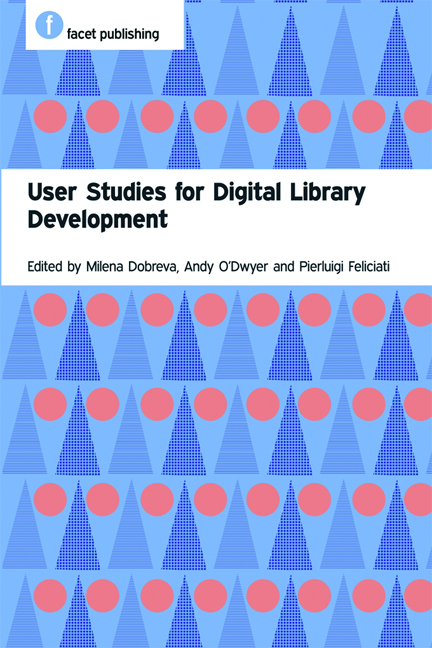Book contents
- Frontmatter
- Contents
- Preface
- Acknowledgements
- Abbreviations
- Glossary
- 1 Introduction: user studies for digital library development
- PART 1 SETTING THE SCENE
- PART 2 METHODS EXPLAINED AND ILLUSTRATED
- PART 3 USER STUDIES IN THE DIGITAL LIBRARY UNIVERSE: WHAT ELSE NEEDS TO BE CONSIDERED?
- 11 User-related issues in multilingual access to multimedia collections
- 12 Children and digital libraries
- 13 User engagement and social media
- 14 Significant others: user studies and digital preservation
- 15 The shift to mobile devices
- 16 Resource discovery for research and course design
- 17 Support for users within an educational or e-learning context
- PART 4 USER STUDIES ACROSS THE CULTURAL HERITAGE SECTOR
- PART 5 PUTTING IT ALL TOGETHER
- Index
13 - User engagement and social media
from PART 3 - USER STUDIES IN THE DIGITAL LIBRARY UNIVERSE: WHAT ELSE NEEDS TO BE CONSIDERED?
Published online by Cambridge University Press: 08 June 2018
- Frontmatter
- Contents
- Preface
- Acknowledgements
- Abbreviations
- Glossary
- 1 Introduction: user studies for digital library development
- PART 1 SETTING THE SCENE
- PART 2 METHODS EXPLAINED AND ILLUSTRATED
- PART 3 USER STUDIES IN THE DIGITAL LIBRARY UNIVERSE: WHAT ELSE NEEDS TO BE CONSIDERED?
- 11 User-related issues in multilingual access to multimedia collections
- 12 Children and digital libraries
- 13 User engagement and social media
- 14 Significant others: user studies and digital preservation
- 15 The shift to mobile devices
- 16 Resource discovery for research and course design
- 17 Support for users within an educational or e-learning context
- PART 4 USER STUDIES ACROSS THE CULTURAL HERITAGE SECTOR
- PART 5 PUTTING IT ALL TOGETHER
- Index
Summary
Introduction
Digital libraries (DLs) are created to preserve collections while providing users with greater access to their content. The evolution of the world wide web during the 21st century has changed expectations among these users regarding how, and in what ways, they consume this content. Compared to other fields with a cultural heritage focus, DLs are collectively more advanced in their attitudes towards user engagement. Their history of building tools that encourage access to content and, in some cases, facilitate communication with other users, parallels the history of the web itself, resulting in a natural migration to social media as a way to further serve users.
As progressive as DLs have been in social media adoption, an invisible barrier still separates source material and the online users seeking to connect with it. Libraries are beginning to reimagine the traditional gatekeeper role with an eye on social curation: can the historical integrity of content be preserved along with usercontributed information? Is there potential future value in comments that seem superfluous now? How can more valuable expression be encouraged among users?
Social media, or Web 2.0 as it was commonly known during its emergence in the mid2000s, refers to an evolution and standardization in webbased programming that reduces the technical expertise and expense needed for individuals to create or share online content and collaborate with others to publish or modify text and multimedia objects with enriched web function ality. In these collaborative environments users may add contextual metadata to an item or a collection, modify descriptions, contribute and edit multimedia, embed library media on their own websites or interact conversation ally around library content. The products arising from these technologies are organized and ranked by search engines according to their popularity, the effectiveness of their metadata or their relevance to niche or targeted audiences. This is a departure from historically scientific means of tracking physical publications in libraries, or the menudriven navigation in traditional websites.
Types of social media
Blogs (WordPress, Blogger): Blogs are websites that feature timely entries containing text commentary or multimedia. These platforms are known for their ability to easily incorporate other forms of social media using embedded code. They also allow for data portability between multiple social media platforms.
- Type
- Chapter
- Information
- User Studies for Digital Library Development , pp. 137 - 148Publisher: FacetPrint publication year: 2012



